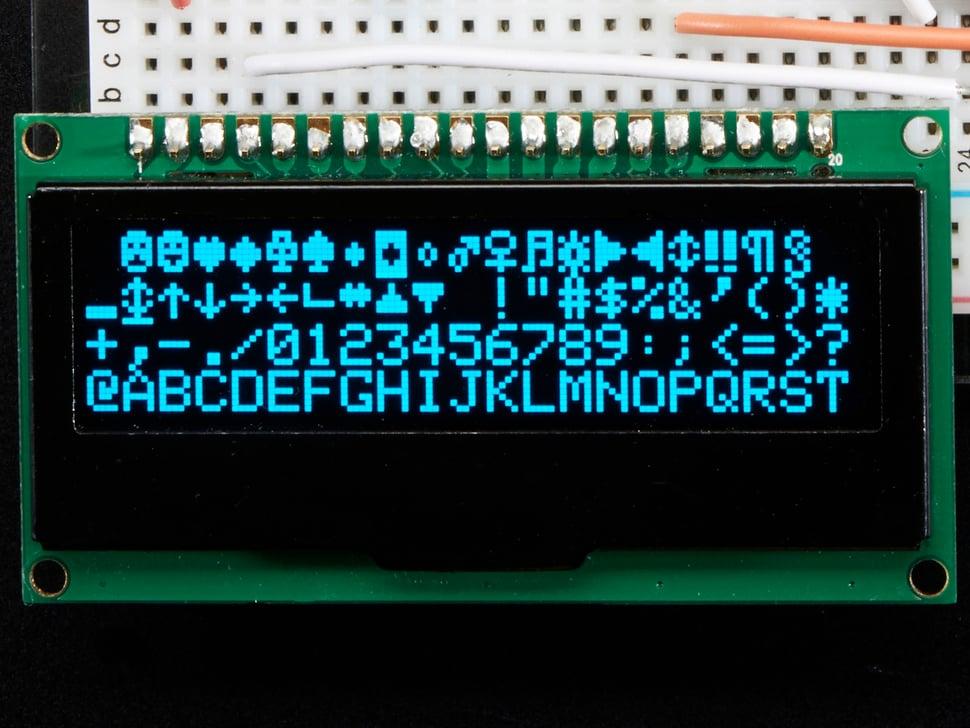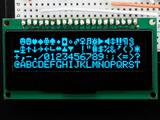Adafruit Monochrome 2.3" 128x32 OLED Graphic Display Module Kit

Description
If you've been interested in monochrome OLEDs but require something larger, this display is a perfect choice. At 2.3 inches diagonally, each of the 128x32 blue OLED pixels provides outstanding readability due to the high contrast OLED technology affords.
The display operates without a backlight, as it generates its own light, significantly reducing power consumption. It boasts a crisp graphic display that's easy to admire. The SSD1305 driver chip supports three communication methods: 8-bit, I2C, or SPI, with SPI being highly efficient using only 4 or 5 wires.
The OLED requires a 3.3V power supply and 3.3V logic levels. A breadboard-compatible level shifter is included, enabling compatibility with 5V logic devices like Arduino. On average, it uses about 50mA from the 3.3V supply depending on display usage.
The integrated boost converter stepping up 3.3V to high voltage for OLEDs, ensures efficient operation. A potential noise from the converter can be minimized with hot glue or foam tape around the inductor. The package includes an OLED module with a bezel, 4 mounting holes, an HC4050 level shifter, a 220uF capacitor, and a stick of header for soldering.
The display initially ships in 8-bit mode but can be switched to SPI or I2C with some soldering, guided by a detailed tutorial and example Arduino library for text and graphics. You'll need a microcontroller with more than 512 bytes of RAM to buffer the display, allowing the rendering of text, bitmaps, and shapes swiftly.
To maintain uniform brightness, turn off the display when idle to prevent the organic LEDs from dimming if a pixel remains on for over 1000 hours. This careful usage ensures prolonged vibrant performance.
Properties
| Brand | Adafruit |
| Model | 2675 |
Delivered in 10 to 30 days
Customer questions
Customer Reviews
- In stock Adafruit NOOds - Flexible LED Filament - 3V 300mm long - Red € 8,75 View product
- In stock Adafruit IR Break Beam Sensors with Premium Wire Header Ends - 3mm LEDs € 3,50 View product
- In stock Adafruit Breadboard-friendly 2.1mm DC barrel jack € 1,25 View product
- In stock Adafruit IR Break Beam Sensor with Premium Wire Header Ends - 5mm LEDs € 7,- View product
- In stock Adafruit Small Enclosed Piezo w/Wires € 1,25 View product
- In stock Adafruit Mini Basic PIR Sensor - BL412 € 2,50 View product
- In stock Adafruit Stainless Thin Conductive Thread - 2 ply - 23 meter/76 ft € 8,25 View product
- In stock Adafruit NOOds - Flexible LED Filament - 3V 300mm long - Blue € 8,75 View product
- In stock Adafruit 2 x CR2032 Coin Cell Battery Holder - 6V output - On/Off switch € 2,50 View product
- In stock Adafruit Pressure-Sensitive Conductive Sheet (Velostat/Linqstat) € 5,75 View product
- In stock Adafruit Stacking Headers for Feather - 12-pin and 16-pin female headers € 1,50 View product
- In stock Adafruit Stereo 3.7W Class D Audio Amplifier - MAX98306 € 10,50 View product
- In stock Adafruit Mono 2.5W Class D Audio Amplifier - PAM8302 € 4,75 View product
- In stock Adafruit White LED Backlight Module - Medium 23mm x 75mm € 3,- View product
- In stock Adafruit NOOds - Flexible LED Filament - 3V 300mm long - Lime Green € 8,25 View product
Recently viewed items
- Adafruit Monochrome 2.3" 128x32 OLED Graphic Display Module Kit € 46,50 View product
- Adafruit Ada Lovelace - Sticker! € 1,25 View product
- Adafruit 12mm Diameter Linear Bearing Pillow Block € 7,- View product
- Adafruit Punk LED Collar Kit - Red LEDs € 34,75 View product
- FREQUENCY - Adafruit's 1st Vinyl Record € 3,50 View product
- Adafruit DotStar Digital LED Strip - White 60 LED - Per Meter 1m € 34,75 View product
- Adafruit NeoPixel Cool White LED w/ Integrated Driver Chip - 10 Pack € 5,75 View product
- Adafruit Sylvia's Super Awesome Project Book - Super Simple Arduino! € 17,50 View product
- Adafruit Top Metal Plate for a Mini Robot Rover Chassis € 5,75 View product
- Adafruit DotStar Digital LED Strip - White 60 LED - Per Meter 3m € 104,50 View product
- Adafruit Fully Reversible Pink/Purple USB A to micro B Cable - 1m long € 4,75 View product
- Adafruit + Cartoon Network Cosplay "The Works" Kit € 69,75 View product
- Adafruit Universal Proto-board PCBs 2cm x 8cm - 3 Pack € 2,75 View product
- Adafruit 13.56MHz RFID/NFC White Tag - NTAG203 Chip € 3,50 View product
- Adafruit Builder's Mat by MOC Industries - 45 x 30cm € 29,- View product










